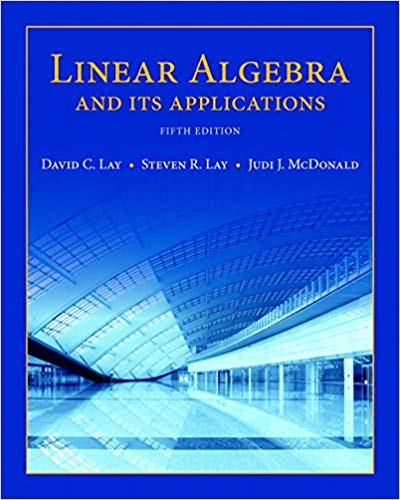
Linear Algebra and Its Applications, 5th Edition
Authors: David C. Lay, Steven R. Lay, Judi J. McDonald
ISBN-13: 978-0321982384
We have solutions for your book!
See our solution for Question 6E from Chapter 1.4 from Lay's Linear Algebra and Its Applications, 5th Edition.
Problem 6E
Chapter:
Problem:
Use the definition of Ax to write the matrix equation as a vector equation, or vice versa...
Step-by-Step Solution
Given information
We have to convert the given matrix equation to vector form of the equation\[\left[ {\begin{array}{*{20}{r}}7&{ - 3}\\2&1\\9&{ - 6}\\{ - 3}&2\end{array}} \right]\left[ {\begin{array}{*{20}{r}}{ - 2}\\{ - 5}\end{array}} \right] = \left[ {\begin{array}{*{20}{r}}1\\{ - 9}\\{12}\\{ - 4}\end{array}} \right]\]Let, \[A = \left[ {\begin{array}{*{20}{r}}7&{ - 3}\\2&1\\9&{ - 6}\\{ - 3}&2\end{array}} \right];\,\,\,x = \left[ {\begin{array}{*{20}{r}}{ - 2}\\{ - 5}\end{array}} \right];\,\,b = \left[ {\begin{array}{*{20}{r}}1\\{ - 9}\\{12}\\{ - 4}\end{array}} \right]\]
Step 1: The Vector Form
Multiply each element of vector $x$ with column A to get the vector form of the equation. Therefore, the vector form is
\[ - 2\left[ {\begin{array}{*{20}{c}}7\\2\\9\\{ - 3}\end{array}} \right] - 5\left[ {\begin{array}{*{20}{c}}{ - 3}\\1\\{ - 6}\\2\end{array}} \right] = \left[ {\begin{array}{*{20}{c}}1\\{ - 9}\\{12}\\{ - 4}\end{array}} \right]\]
We have to convert the given matrix equation to vector form of the equation\[\left[ {\begin{array}{*{20}{r}}7&{ - 3}\\2&1\\9&{ - 6}\\{ - 3}&2\end{array}} \right]\left[ {\begin{array}{*{20}{r}}{ - 2}\\{ - 5}\end{array}} \right] = \left[ {\begin{array}{*{20}{r}}1\\{ - 9}\\{12}\\{ - 4}\end{array}} \right]\]Let, \[A = \left[ {\begin{array}{*{20}{r}}7&{ - 3}\\2&1\\9&{ - 6}\\{ - 3}&2\end{array}} \right];\,\,\,x = \left[ {\begin{array}{*{20}{r}}{ - 2}\\{ - 5}\end{array}} \right];\,\,b = \left[ {\begin{array}{*{20}{r}}1\\{ - 9}\\{12}\\{ - 4}\end{array}} \right]\]
Step 1: The Vector Form
Multiply each element of vector $x$ with column A to get the vector form of the equation. Therefore, the vector form is
\[ - 2\left[ {\begin{array}{*{20}{c}}7\\2\\9\\{ - 3}\end{array}} \right] - 5\left[ {\begin{array}{*{20}{c}}{ - 3}\\1\\{ - 6}\\2\end{array}} \right] = \left[ {\begin{array}{*{20}{c}}1\\{ - 9}\\{12}\\{ - 4}\end{array}} \right]\]